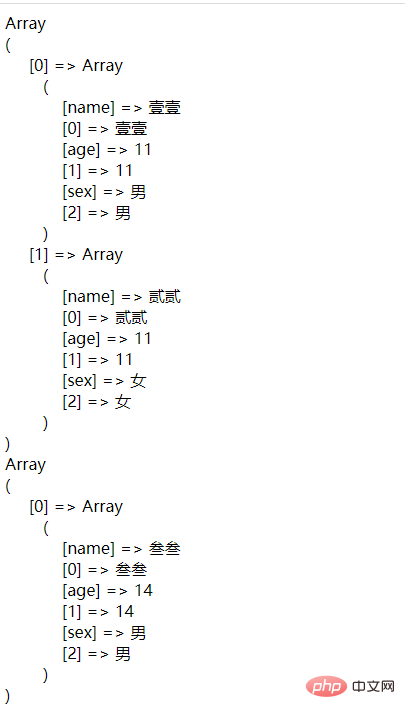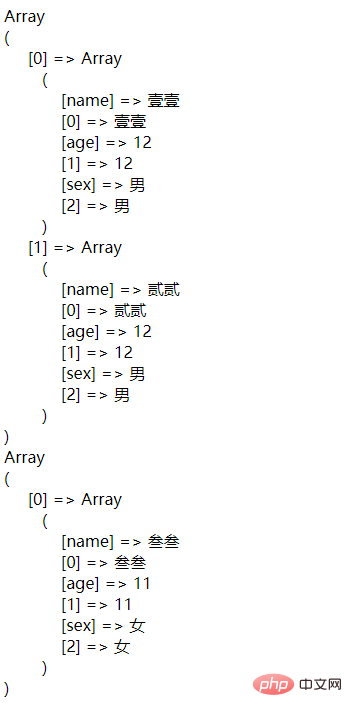 Backend Development
Backend Development
 PHP Tutorial
PHP Tutorial
 PHP database learning: How to use PDO to execute SQL statements?
PHP database learning: How to use PDO to execute SQL statements?
PHP database learning: How to use PDO to execute SQL statements?
In the previous article, I brought you "PHP database learning: How to use PDO to connect to the database?" ", which gives you a detailed introduction to how to connect to the database through PDO in PHP. In this article, we will continue to look at how to use PDO to execute SQL statements in PHP. I hope everyone has to help!

In the previous article, we have learned how PHP connects to the database through PDO. To connect to the database, you must execute SQL statements. In PDO, we can use three ways to execute SQL statements, namely exec() method, query() method, and prepared statement prepare() and execute() methods. Then let’s take a look together.
<strong><span style="font-size: 20px;">exec() </span></strong>Method
When we execute INSERT , UPDATE and DELETE and other SQL statements that do not need to return a result set, we can use the exec() method in the PDO object. After successful execution using this method, the returned result will be affected. The number of lines, the syntax format of the
exec() method is as follows:
PDO::exec(string $sql)
It should be noted that:
$ sqlis the SQL statement to be executed.exec()The method will not obtain the corresponding results from the SELECT query statement.
Then we try to add a piece of data to the database through an example. The example is as follows:
<?php
$dsn = 'mysql:host=127.0.0.1;dbname=test';
$user = 'root';
$pwd = 'root';
try{
$pdo = new PDO($dsn,$user,$pwd);
$sql = "insert into user(name,age,sex) values('壹壹','21','男')";
$res = $pdo -> exec($sql);
if($res) echo '成功添加 '.$res.' 条数据!';
}catch(PDOException $e){
echo '数据库连接失败:'.$e -> getMessage();
}
?>Output result:

As can be seen from the above example, we successfully added a piece of data to the database through the exec() method, and the returned result is the number of affected rows. If you want to return an object, you can use the query() method. Next, let's look at another way to execute SQL statements: query() method.
<strong><span style="max-width:90%">query() </span></strong>Method
In the above example The exec() method can return these statement information that do not need to return a result set. When executing a SELECT query statement that needs to return a result set, we need to pass the query() statement. If this method is executed successfully, the repentant home country is a PDOStatement object.
If you use the query() method and want to know the total number of data rows obtained, you can use the rowCount() method in the PDOStatement object to obtain it.
The syntax format of the query() method is as follows:
PDO::query(string $sql) PDO::query(string $sql, int $PDO::FETCH_COLUMN, int $colno) PDO::query(string $sql, int $PDO::FETCH_CLASS, string $classname, array $ctorargs) PDO::query(string $sql, int $PDO::FETCH_INTO, object $object)
What needs to be noted is:
$sql is required The executed SQL statement; the remaining parameters are used to set the default fetch mode for the statement, which is equivalent to calling the result object PDOStatement::setFetchMode() method.
Then we use the query() method to query the data we added earlier. The example is as follows:
<?php
$dsn = 'mysql:host=127.0.0.1;dbname=test';
$user = 'root';
$pwd = 'root';
try{
$pdo = new PDO($dsn,$user,$pwd);
$sql = "SELECT * FROM user WHERE name='壹壹'";
$res = $pdo -> query($sql,PDO::FETCH_ASSOC);
print_r($res);
}catch(PDOException $e){
echo '数据库连接失败:'.$e -> getMessage();
}
?>Output result:

The use of query() and exec() methods has the following points to note:
Both query() and exec() can execute all SQL statements, but the return values are different;
query() can realize all the functions of exec();
When the select statement is applied to exec(), 0 is always returned;
If you want to see the specific results of the query, you can complete the loop output through the foreach statement .
<strong>##prepare()<span style="font-size: 20px;"></span></strong> and execute() methods
prepare() method in the PDO object to prepare a query to be executed, and then use the execute() method in the PDOStatement object to execute it. Then let's take a look at the prepare() and execute() methods.
PDO::prepare(string $statement[, array $driver_options = array()])
$statement
represents It must be a SQL statement template that is valid for the target database;$driver_options
represents an optional parameter, which is an optional parameter of array type and contains one or more Key-value pairs to set properties for the returned PDOStatement object.
PDOStatement::execute([array $input_parameters])
参数
$input_parameters为一个元素个数和将被执行的 SQL 语句中绑定的参数一样多的数组。SQL 语句模板中可以包含零个或多个参数占位标记,格式可以是命名(:name)或问号(?)的形式,当它执行时将用真实数据取代。
在同一个 SQL 语句里,命名和问号形式不能同时使用,只能选择其中一种参数形式。如果使用命名形式的占位标记,那么标记的命名必须是唯一的。
接下来我们看一下使用命名形式的参数占位符,查询指定的 SQL 语句,示例如下:
<?php
$dsn = 'mysql:host=127.0.0.1;dbname=test';
$user = 'root';
$pwd = 'root';
try{
$pdo = new PDO($dsn,$user,$pwd);
$sql = "SELECT name,age,sex FROM user WHERE age = :age";
$sth = $pdo -> prepare($sql);
$sth -> execute([':age'=>11]);
$res1 = $sth -> fetchAll();
$sth -> execute(array(':age'=>14));
$res2 = $sth -> fetchAll();
echo '<pre class="brush:php;toolbar:false">';
print_r($res1);
print_r($res2);
}catch(PDOException $e){
echo '数据库连接失败:'.$e -> getMessage();
}
?>输出结果:

上述示例是使用命名形式的参数占位符,查询指定的 SQL 语句,接下来我们看一下使用问号形式的参数占位符,查询指定的 SQL 语句。示例如下:
<?php
$dsn = 'mysql:host=127.0.0.1;dbname=test';
$user = 'root';
$pwd = 'root';
try{
$pdo = new PDO($dsn,$user,$pwd);
$sql = "SELECT name,age,sex FROM user WHERE age = ? AND sex = ?";
$sth = $pdo -> prepare($sql);
$sth -> execute([12,'男']);
$res1 = $sth -> fetchAll();
$sth -> execute(array(11,'女'));
$res2 = $sth -> fetchAll();
echo '<pre class="brush:php;toolbar:false">';
print_r($res1);
print_r($res2);
}catch(PDOException $e){
echo '数据库连接失败:'.$e -> getMessage();
}
?>输出结果:

由此我们便通过使用问号形式的参数占位符,查询指定的 SQL 语句。
大家如果感兴趣的话,可以点击《PHP视频教程》进行更多关于PHP知识的学习。
The above is the detailed content of PHP database learning: How to use PDO to execute SQL statements?. For more information, please follow other related articles on the PHP Chinese website!

Hot AI Tools

Undresser.AI Undress
AI-powered app for creating realistic nude photos

AI Clothes Remover
Online AI tool for removing clothes from photos.

Undress AI Tool
Undress images for free

Clothoff.io
AI clothes remover

Video Face Swap
Swap faces in any video effortlessly with our completely free AI face swap tool!

Hot Article

Hot Tools

Notepad++7.3.1
Easy-to-use and free code editor

SublimeText3 Chinese version
Chinese version, very easy to use

Zend Studio 13.0.1
Powerful PHP integrated development environment

Dreamweaver CS6
Visual web development tools

SublimeText3 Mac version
God-level code editing software (SublimeText3)

Hot Topics
 1664
1664
 14
14
 1423
1423
 52
52
 1317
1317
 25
25
 1268
1268
 29
29
 1243
1243
 24
24
 Explain JSON Web Tokens (JWT) and their use case in PHP APIs.
Apr 05, 2025 am 12:04 AM
Explain JSON Web Tokens (JWT) and their use case in PHP APIs.
Apr 05, 2025 am 12:04 AM
JWT is an open standard based on JSON, used to securely transmit information between parties, mainly for identity authentication and information exchange. 1. JWT consists of three parts: Header, Payload and Signature. 2. The working principle of JWT includes three steps: generating JWT, verifying JWT and parsing Payload. 3. When using JWT for authentication in PHP, JWT can be generated and verified, and user role and permission information can be included in advanced usage. 4. Common errors include signature verification failure, token expiration, and payload oversized. Debugging skills include using debugging tools and logging. 5. Performance optimization and best practices include using appropriate signature algorithms, setting validity periods reasonably,
 Explain late static binding in PHP (static::).
Apr 03, 2025 am 12:04 AM
Explain late static binding in PHP (static::).
Apr 03, 2025 am 12:04 AM
Static binding (static::) implements late static binding (LSB) in PHP, allowing calling classes to be referenced in static contexts rather than defining classes. 1) The parsing process is performed at runtime, 2) Look up the call class in the inheritance relationship, 3) It may bring performance overhead.
 PHP Program to Count Vowels in a String
Feb 07, 2025 pm 12:12 PM
PHP Program to Count Vowels in a String
Feb 07, 2025 pm 12:12 PM
A string is a sequence of characters, including letters, numbers, and symbols. This tutorial will learn how to calculate the number of vowels in a given string in PHP using different methods. The vowels in English are a, e, i, o, u, and they can be uppercase or lowercase. What is a vowel? Vowels are alphabetic characters that represent a specific pronunciation. There are five vowels in English, including uppercase and lowercase: a, e, i, o, u Example 1 Input: String = "Tutorialspoint" Output: 6 explain The vowels in the string "Tutorialspoint" are u, o, i, a, o, i. There are 6 yuan in total
 What are PHP magic methods (__construct, __destruct, __call, __get, __set, etc.) and provide use cases?
Apr 03, 2025 am 12:03 AM
What are PHP magic methods (__construct, __destruct, __call, __get, __set, etc.) and provide use cases?
Apr 03, 2025 am 12:03 AM
What are the magic methods of PHP? PHP's magic methods include: 1.\_\_construct, used to initialize objects; 2.\_\_destruct, used to clean up resources; 3.\_\_call, handle non-existent method calls; 4.\_\_get, implement dynamic attribute access; 5.\_\_set, implement dynamic attribute settings. These methods are automatically called in certain situations, improving code flexibility and efficiency.
 PHP and Python: Comparing Two Popular Programming Languages
Apr 14, 2025 am 12:13 AM
PHP and Python: Comparing Two Popular Programming Languages
Apr 14, 2025 am 12:13 AM
PHP and Python each have their own advantages, and choose according to project requirements. 1.PHP is suitable for web development, especially for rapid development and maintenance of websites. 2. Python is suitable for data science, machine learning and artificial intelligence, with concise syntax and suitable for beginners.
 PHP in Action: Real-World Examples and Applications
Apr 14, 2025 am 12:19 AM
PHP in Action: Real-World Examples and Applications
Apr 14, 2025 am 12:19 AM
PHP is widely used in e-commerce, content management systems and API development. 1) E-commerce: used for shopping cart function and payment processing. 2) Content management system: used for dynamic content generation and user management. 3) API development: used for RESTful API development and API security. Through performance optimization and best practices, the efficiency and maintainability of PHP applications are improved.
 PHP: A Key Language for Web Development
Apr 13, 2025 am 12:08 AM
PHP: A Key Language for Web Development
Apr 13, 2025 am 12:08 AM
PHP is a scripting language widely used on the server side, especially suitable for web development. 1.PHP can embed HTML, process HTTP requests and responses, and supports a variety of databases. 2.PHP is used to generate dynamic web content, process form data, access databases, etc., with strong community support and open source resources. 3. PHP is an interpreted language, and the execution process includes lexical analysis, grammatical analysis, compilation and execution. 4.PHP can be combined with MySQL for advanced applications such as user registration systems. 5. When debugging PHP, you can use functions such as error_reporting() and var_dump(). 6. Optimize PHP code to use caching mechanisms, optimize database queries and use built-in functions. 7
 The Enduring Relevance of PHP: Is It Still Alive?
Apr 14, 2025 am 12:12 AM
The Enduring Relevance of PHP: Is It Still Alive?
Apr 14, 2025 am 12:12 AM
PHP is still dynamic and still occupies an important position in the field of modern programming. 1) PHP's simplicity and powerful community support make it widely used in web development; 2) Its flexibility and stability make it outstanding in handling web forms, database operations and file processing; 3) PHP is constantly evolving and optimizing, suitable for beginners and experienced developers.



